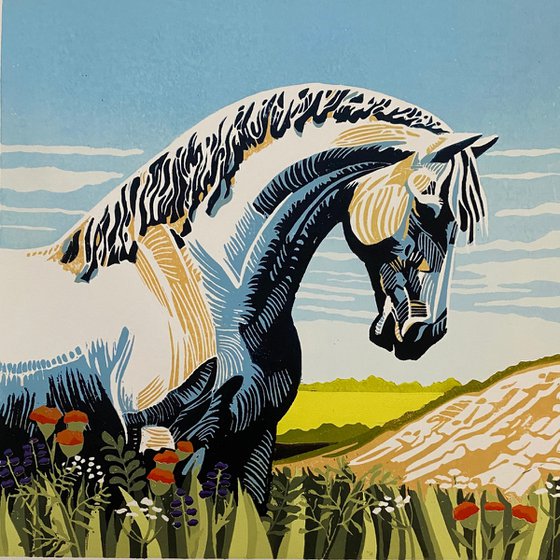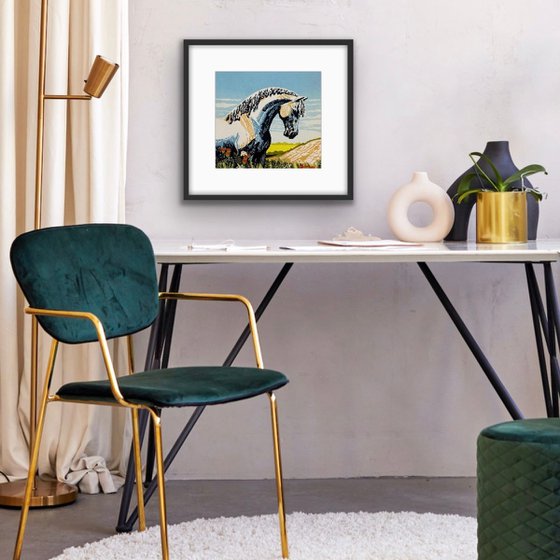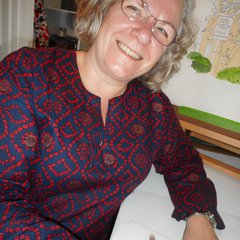- By medium
- By subject
- By budget
- Sales
- Gift cards
- Discover all art
- Artists
- Editors’ picks
- Ideas
Artwork description:
When I was making The Icons Collection, I wanted to include a chalk horse. Living in Wiltshire we have several white horses carved into the chalk hills, the scale of this artwork is considerable. Dr Christopher Alsop, also known as the mad doctor, was responsible for the one nearest me in Cherhill. He shouted instructions at people on the hill through a megaphone to place white flags for the horse outline in 1780.
Despite really wanting to include one in the collection I really struggled to convey the magnificence I wanted to when I was replicating the chalk horses as they are in our landscape. After various failed attempts I went back to the drawing board and turned it all on its head. I board blasted what I wanted my white horse to look like, magnificent and powerful, almost mystical, and part of the land, and it had to be white. Unusually for me, working form words I developed what was to become The Wiltshire White Horse.
A reduction Lino print is made by using the same piece of Lino to print all the colours. Each time a layer is printed then more of the surface of the Lino is removed, reducing the surface area. Each me you put a layer of ink on the Lino and print it, the Lino must come into contact with the paper at the same place, otherwise the picture does not align and will not be usable. Reduction lino printing requires careful planning and precision, as mistakes cannot be easily corrected once a layer of ink has been applied. It is a time-consuming process, but the end result can be a beautiful, vibrant and layered print. I start off intending to make 10 images and usually end up with 7 or 8, but it can be less.
The Wiltshire White Horse
30 x 30 cm
An edition of 8.
Caligo Safewash ink
Somerset Satin 300 GSM paper.
Titled, numbered and signed on the front.
Materials used:
Caligo Safewash Ink, Fabriano paper
Tags:
#landscape #mystical #white horse #wiltshire #lino cutThe Wiltshire White Horse (2023) Linocut
by Joanne Spencer
34 Artist Reviews
£130
- Linocut on Paper
- From a limited edition of 8
- Size: 30 x 30 x 1cm (unframed) / 30 x 30cm (actual image size)
- Ready to hang
- Signed and numbered on the front
- Style: Impressionistic
- Subject: Landscapes, sea and sky
- Hurry only 1 left in stock
Loading
Artwork description
When I was making The Icons Collection, I wanted to include a chalk horse. Living in Wiltshire we have several white horses carved into the chalk hills, the scale of this artwork is considerable. Dr Christopher Alsop, also known as the mad doctor, was responsible for the one nearest me in Cherhill. He shouted instructions at people on the hill through a megaphone to place white flags for the horse outline in 1780.
Despite really wanting to include one in the collection I really struggled to convey the magnificence I wanted to when I was replicating the chalk horses as they are in our landscape. After various failed attempts I went back to the drawing board and turned it all on its head. I board blasted what I wanted my white horse to look like, magnificent and powerful, almost mystical, and part of the land, and it had to be white. Unusually for me, working form words I developed what was to become The Wiltshire White Horse.
A reduction Lino print is made by using the same piece of Lino to print all the colours. Each time a layer is printed then more of the surface of the Lino is removed, reducing the surface area. Each me you put a layer of ink on the Lino and print it, the Lino must come into contact with the paper at the same place, otherwise the picture does not align and will not be usable. Reduction lino printing requires careful planning and precision, as mistakes cannot be easily corrected once a layer of ink has been applied. It is a time-consuming process, but the end result can be a beautiful, vibrant and layered print. I start off intending to make 10 images and usually end up with 7 or 8, but it can be less.
The Wiltshire White Horse
30 x 30 cm
An edition of 8.
Caligo Safewash ink
Somerset Satin 300 GSM paper.
Titled, numbered and signed on the front.
Materials used:
Caligo Safewash Ink, Fabriano paper
Tags:
#landscape #mystical #white horse #wiltshire #lino cut14 day money back guaranteeLearn more


